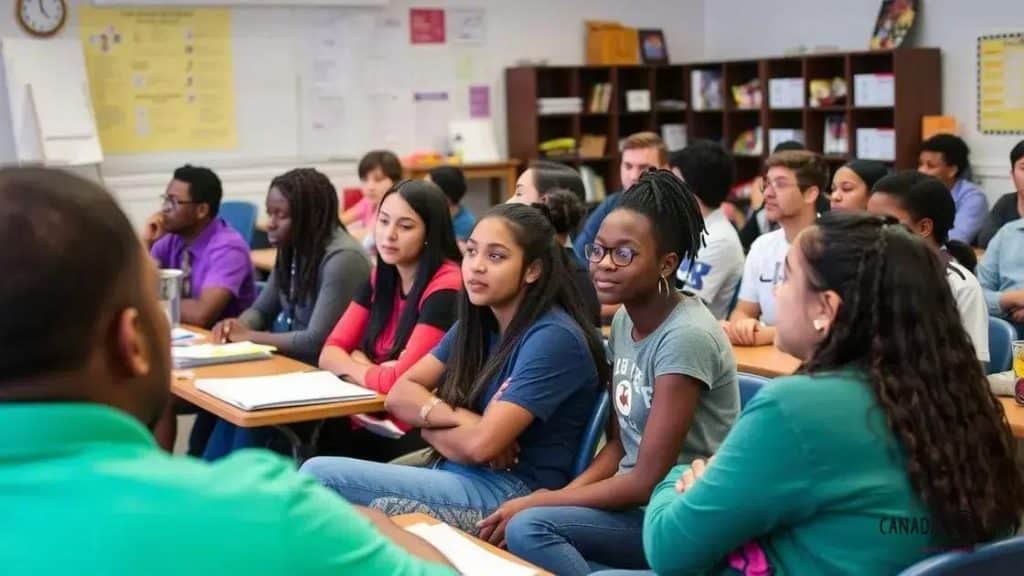Efforts to increase access to higher education for minority students

Efforts to increase access to higher education for minority students involve community initiatives, mentorship programs, and the integration of technology to overcome barriers and provide equitable opportunities for success.
Efforts to increase access to higher education for minority students are crucial in shaping a more equitable education system. Have you ever wondered how these initiatives can transform lives and communities? Let’s dive into the key strategies behind this important work.
Understanding the barriers to higher education
Understanding the barriers to higher education is essential for improving access for all students. Many factors can hinder minority students from pursuing their academic goals. Some challenges are evident, while others may not be as noticeable at first glance.
Key Barriers to Access
Several significant barriers exist that can impact students. These may include financial constraints, lack of support systems, and institutional biases. Each of these challenges requires careful consideration to create effective solutions. Here are some of the main barriers:
- Financial challenges: Tuition costs, fees, and living expenses can be overwhelming for many students.
- Lack of information: Students may not have access to crucial information about scholarships and financial aid.
- Limited support: Many minority students lack mentors or guidance throughout their educational journey.
- Systemic biases: Institutional practices can create obstacles for minority students, affecting admission and retention.
Additionally, cultural factors can also play a role in shaping aspirations and expectations. For instance, family expectations and community values can significantly influence a student’s decision to pursue higher education. Understanding these nuances is vital for developing targeted strategies.
Moreover, mental health is another area of concern. The stress of navigating a challenging educational landscape can lead to anxiety and burnout. Establishing strong support services is crucial to help students cope and thrive in their academic environments.
Ultimately, addressing these barriers is a community effort. Schools, families, and local organizations must work together to create pathways to success for minority students. By identifying and understanding these challenges, we can pave the way for a brighter, more inclusive future in higher education.
Strategies for increasing access
Strategies for increasing access to higher education are crucial for creating a more equitable environment for all students. Various approaches can be implemented to break down barriers and ensure that minority students have the support they need.
Scholarship Programs
Establishing scholarship programs can alleviate the financial burden many students face. Scholarships specifically aimed at minority students can provide the necessary funds to cover tuition and fees. These programs not only offer financial assistance but also often include mentorship opportunities to guide students through their academic journeys.
- Need-based scholarships: Target low-income students to help them afford college.
- Merit-based scholarships: Recognize and reward academic achievements among minority students.
- Community-funded scholarships: Engage local businesses and organizations to support local students.
In addition to scholarships, creating mentorship and support networks is essential. Connecting students with mentors can help them navigate the complexities of higher education. Mentors can provide guidance, encouragement, and resources. This support can significantly impact a student’s ability to succeed academically.
Outreach Programs
Outreach initiatives that target schools with high minority populations are another effective strategy. These programs can introduce students to the possibilities of higher education early on. By collaborating with schools, colleges can offer workshops, campus tours, and informational sessions that demystify the college experience.
Furthermore, fostering relationships with community organizations can enhance outreach. Local groups often understand the unique challenges students face and can help design programs that resonate with them. Engaging parents and families is also vital in fostering a culture that values education.
Finally, policies that promote inclusivity within higher education institutions make a significant difference. This includes adopting practices that ensure fair admissions processes and providing resources that cater to the needs of minority students. Overall, effective strategies for increasing access often involve a combination of financial support, community engagement, and organizational commitment to equity.
Community initiatives and collaboration
Community initiatives and collaboration play a significant role in enhancing access to higher education for minority students. These grassroots efforts can create supportive environments where students feel encouraged and empowered to pursue their academic goals.
Building Partnerships
Establishing partnerships between schools, local organizations, and higher education institutions is essential. These collaborations can lead to programs that directly address the needs of minority students. Schools can work with colleges to develop mentorship opportunities that connect students with college students and professionals who share similar backgrounds.
- Local businesses: Engaging local businesses can provide internships and job opportunities for students, allowing them to gain valuable experience.
- Community centers: These centers can host workshops and events that promote higher education and provide resources.
- Nonprofit organizations: Partnering with nonprofits focused on education can help implement programs tailored to the needs of minority communities.
Moreover, community initiatives can serve as platforms for awareness and advocacy. They can highlight the challenges faced by minority students and encourage dialogue on improving access to education. For example, local events can bring together students, families, educators, and community leaders to discuss resources and strategies for success.
After-school Programs
After-school programs that focus on academic support are another way communities can contribute. These programs can provide tutoring and mentoring, helping students improve their grades and stay engaged with their learning. When students receive help outside regular school hours, they can build confidence and skills essential for higher education.
Additionally, by including parents and families in these initiatives, communities can strengthen support networks. Family engagement is vital to a student’s success. When families understand the value of education and are involved in their children’s academic lives, students are more likely to succeed. This collaborative approach can create a culture that values education and motivates students to aim high.
Overall, effective community initiatives equip students with the resources and support they need to navigate the challenges of higher education. By fostering collaboration among various stakeholders, we can create a vibrant ecosystem that empowers minority students to achieve their educational aspirations.
Success stories: Programs making a difference

Success stories highlight the impact of various programs that truly make a difference in increasing access to higher education for minority students. These initiatives showcase not only the ability to overcome barriers but also the transformative power of education.
Programs That Empower
Many effective programs have emerged across the country, each focusing on unique strategies to assist minority students. These programs often combine mentorship, academic support, and community involvement to set students up for success. For instance, one prominent program focuses on pairing students with mentors who share similar backgrounds and can provide guidance.
- Mentorship Programs: These initiatives connect students with professionals who offer advice and encouragement.
- After-school Tutoring: Many programs provide academic help outside regular school hours, focusing on subjects where students struggle.
- College Prep Workshops: These workshops inform students about the college application process, financial aid, and essay writing.
These examples show how targeted support can lead to significant improvements in student outcomes. Moreover, success stories often feature students who have faced numerous challenges but achieved their educational aspirations through these programs.
Community Engagement
In addition to direct support, community engagement plays a crucial role in these success stories. For instance, many programs involve parents and families, ensuring that students have a supportive home environment. When families understand the education system and the importance of higher education, they are better equipped to encourage their children.
Another essential aspect of these programs is their adaptability. Many of them evolve based on the needs of the students they serve. By continuously seeking feedback and adjusting curricula and support services, they ensure that they effectively address the changing landscape of education.
Further, some programs tackle the issue of financial accessibility by offering scholarships and grants exclusively for minority students. This financial support can reduce the burden of tuition and encourage students to pursue their dreams without the fear of overwhelming debt.
Overall, these success stories illustrate how dedicated initiatives can pave the way for minority students to achieve their educational goals. By combining mentorship, community involvement, and financial assistance, these programs demonstrate the incredible potential of collaborative efforts in overcoming barriers to higher education.
Future trends in education access
Future trends in education access are shaping how students, especially from minority backgrounds, will pursue higher education. With the rise of technology and changing societal norms, it’s essential to explore how these trends can create opportunities for all.
Increased Use of Technology
One major trend is the growing reliance on technology to enhance learning opportunities. Online courses and virtual classrooms make education more accessible than ever before. This shift allows minority students to take classes from anywhere, breaking down geographical barriers.
- Remote Learning: Students can attend lectures and engage with instructors without being physically present on campus.
- Online Resources: A plethora of resources, like videos and interactive tools, can support diverse learning styles.
- Flexible Scheduling: Online education often offers greater flexibility, allowing students to work while studying.
Moreover, the rise of mobile technology means that students have access to information at their fingertips. This enhances their ability to research colleges, scholarships, and programs that suit their needs.
Engagement of Community Organizations
Another trend is the increasing collaboration between educational institutions and community organizations. Local nonprofits and businesses are stepping up to provide resources and support for minority students.
Programs often include workshops, mentorship, and networking opportunities that demystify the college application process. By leveraging local expertise, these organizations can help students navigate their educational journeys more effectively.
Furthermore, community-based initiatives can lead to scholarship opportunities specifically designed for minority students. This financial support is crucial in reducing the barriers to higher education.
Focus on Equity and Inclusion
Finally, there is a strong emphasis on equity and inclusion within educational institutions. Schools and colleges are increasingly recognizing the need for diverse perspectives in the classroom. This not only improves learning outcomes but also prepares all students for a multicultural world.
Policies promoting diversity in admissions and recruitment aim to create a more inclusive environment. As these trends continue to evolve, it is crucial that educational institutions remain committed to fostering diversity and ensuring equitable access.
In conclusion, the future of education access is dynamic and full of potential. By leveraging technology, engaging communities, and promoting equity, we can create a more accessible and inclusive landscape for minority students seeking higher education.
FAQ – Frequently Asked Questions about Increasing Access to Higher Education for Minority Students
What are some common barriers for minority students in higher education?
Common barriers include financial challenges, lack of access to information, limited support systems, and systemic biases within educational institutions.
How can technology improve access to education?
Technology enables remote learning opportunities, provides access to online resources, and supports flexible scheduling for students.
Why is community support important for minority students?
Community support helps students navigate educational routes, offers resources like scholarships, and fosters an encouraging environment to pursue higher education.
What strategies are effective in increasing access to higher education?
Effective strategies include mentorship programs, outreach initiatives, scholarship opportunities, and fostering partnerships between educational and community organizations.





